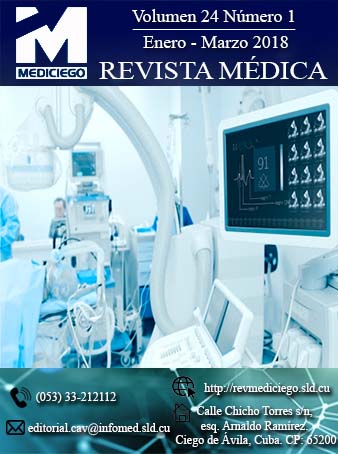Canine autotransplant as a therapeutic option to correct malocclusions
Abstract
Introduction: dental autotransplant is performed more frequently in patients with dentoalveolar trauma. In cases of dental losses for other reasons, the osseointegrated implant is currently used, so the former has been relegated.
Objective: to present the case of a patient who underwent autotransplantation of an upper canine as a therapeutic option to correct malocclusion.
Case presentation: female patient, 22 years old, with the left upper canine retained. Six months ago a tie was carried out during an active treatment in orthodontics. The x-ray showed the impacted canine and angulation that made orthodontic movement difficult. In the surgical procedure, the canine autologous technique was used. She had no surgical complications and evolved satisfactorily.
Discussion: dental retention is characterized by the lack of eruption of the tooth and a set of alterations. It occurs most frequently in adolescents and young adults, and is related to the eruption of third molars and canines. The treatment of choice is the relocation of the tooth included in the dental arch, and can be done through surgical-orthodontic or surgical procedures.
Conclusions: dental autotransplantation is a viable option to treat malocclusions. The functionality of the transplanted tooth was good, as well as its aesthetics and integration. Although the use of this technique is limited to the donor tooth, if it meets the conditions to perform the transplant, it should be considered.Downloads
Published
How to Cite
Issue
Section
License
MediCiego does not apply publication charges. The journal is available in open access without restrictions, in compliance with the international policy on open access to information for the exchange of global knowledge.
The authors will retain their copyright and guarantee the journal the right of first publication of their work. MediCiego is licensed under the Creative Commons Attribution-NonCommercial 4.0 International license (CC BY-NC 4.0) https://creativecommons.org/licenses/by-nc/4.0/deed.es_ES), so it is allowed to copy, reproduce, distribute, publicly communicate the work and generate derivative works, as long as the original author is cited and acknowledged. However, it is not allowed to use the original work for commercial or lucrative purposes.
Authors must sign a copyright agreement through an affidavit of authorship and originality, before publishing.
The authors authorize the publication of their writings; they retain the copyright, and assign to the journal all the rights protected by the Copyright Law that governs Cuba, and implies the edition to disseminate the work.
Likewise, they may establish additional agreements for the non-exclusive distribution of the version of the work published in the journal (for example, placing it in an institutional repository or publishing it in a book), with the recognition of having been first published in this journal.
Declaration of authorship: download here the Affidavit

























